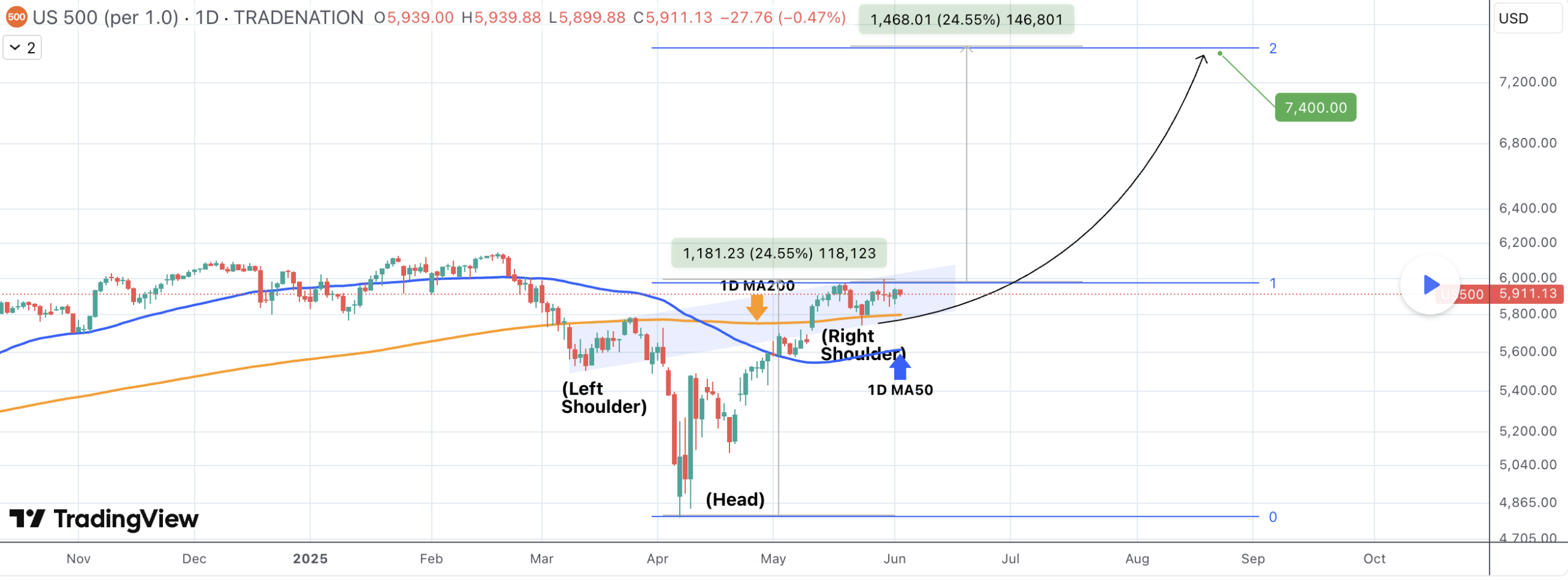S&P 500 Poised for Major Rally as AI Momentum and Technical Patterns Align
04.06.2025 15:00 1 min. read Alexander Stefanov
A sharp rally could be brewing for the S&P 500, with analysts suggesting the index may push toward 7,400 in the coming months—a move that would mark a significant leap from its current level near 5,950.
The projection comes from TradingShot, which pointed to a classic bullish signal forming on the charts. Their analysis highlights an inverse head-and-shoulders structure that developed over spring, hinting at a trend reversal. The pattern, completed with a breakout in late May, maps out a potential 24–25% surge if momentum holds.
Fueling this outlook is the index’s recent return above its 50-day and 200-day moving averages—indicators typically seen as signs of renewed institutional confidence. The upward trajectory gained further strength after the market shook off an April dip tied to tariff fears. Since then, the S&P 500 has rebounded sharply, climbing 20% despite intensifying trade tensions between the U.S. and China.
Major financial institutions are also raising their targets. Goldman Sachs sees the index reaching 6,500 by year’s end, while Bank of America forecasts 6,666, both citing strong earnings and stable economic policies. Oppenheimer is even more bullish, projecting 7,100, driven largely by the market’s embrace of artificial intelligence technologies.
With technicals aligning and optimism building, the S&P 500 could be on track for a powerful breakout—one that extends well into the second half of 2025.
-
1
U.S. Bank Advises Clients to Drop These Cryptocurrencies
29.06.2025 10:00 2 min. read -
2
FTX Halts Recovery Payments in 49 Countries: Here Is the List
04.07.2025 18:00 2 min. read -
3
Chinese Tech Firms Turn to Crypto for Treasury Diversification
26.06.2025 17:00 1 min. read -
4
What Are the Key Trends in European Consumer Payments for 2024?
29.06.2025 8:00 2 min. read -
5
What Brian Armstrong’s New Stats Reveal About Institutional Crypto Growth
29.06.2025 15:00 2 min. read
JPMorgan Lawsuit Threatens Crypto Access and Open Banking Rights
JPMorgan and other major U.S. banks are under fire for a lawsuit aimed at dismantling the Consumer Financial Protection Bureau’s (CFPB) newly established “Open Banking Rule.”
Greed Holds as Market Momentum Builds: What is the Market Sentiment
The crypto market remains firmly in “Greed” territory, with CoinMarketCap’s Fear & Greed Index clocking in at 69/100 on July 19. Despite a modest 24-hour dip from 71, the index has now held above 60 for 11 consecutive days.
Top 7 Crypto Project Updates This Week
The crypto industry saw major advancements this past week across DeFi, NFT, Layer 2, and AI-powered platforms.
Peter Thiel-Backed Crypto Exchange Files for IPO
Cryptocurrency exchange Bullish, backed by billionaire investor Peter Thiel, has officially filed for an initial public offering (IPO), marking a major step toward entering the public markets.
-
1
U.S. Bank Advises Clients to Drop These Cryptocurrencies
29.06.2025 10:00 2 min. read -
2
FTX Halts Recovery Payments in 49 Countries: Here Is the List
04.07.2025 18:00 2 min. read -
3
Chinese Tech Firms Turn to Crypto for Treasury Diversification
26.06.2025 17:00 1 min. read -
4
What Are the Key Trends in European Consumer Payments for 2024?
29.06.2025 8:00 2 min. read -
5
What Brian Armstrong’s New Stats Reveal About Institutional Crypto Growth
29.06.2025 15:00 2 min. read



